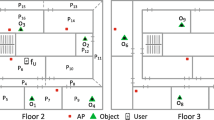Abstract
Exploring white spaces in the indoor environment has been recognized as a promising way to satisfy the rapid growth of the wireless spectrum demand. Although a few indoor white space exploration systems have been proposed in the past few years, they mainly focused on exploring white spaces at a small set of candidate locations. However, what we need are the white space availabilities at arbitrary indoor locations instead of only those at the candidate locations. In this paper, we first perform an indoor TV spectra measurement to study the characteristics of indoor white spaces in a fine-grained way. Then, we propose a Fine-gRained Indoor white Space Estimation mechanism, called FRISE, which could accurately estimate the white space availabilities at arbitrary indoor locations. FRISE mainly consists of a method to determine the positions of candidate locations and an accurate spatial interpolation algorithm. Furthermore, we evaluate the performance of FRISE based on real-world measured data. The evaluation results show that FRISE outperforms the existing methods in estimating white spaces at arbitrary indoor locations.
Access this chapter
Tax calculation will be finalised at checkout
Purchases are for personal use only
Similar content being viewed by others
References
Bonilla, E.V., Chai, K.M., Williams, C.: Multi-task gaussian process prediction. In: Proceedings of NIPS, pp. 153–160 (2007)
Caselton, W.F., Zidek, J.V.: Optimal monitoring network designs. Stat. Prob. Lett. 2(4), 223–227 (1984)
Chai, K.M., Williams, C., Klanke, S., Vijayakumar, S.: Multi-task Gaussian process learning of robot inverse dynamics. In: Proceedings of NIPS, pp. 265–272 (2009)
Chen, Z., Zhang, Y.: Providing spectrum information service using TV white space via distributed detection system. IEEE Trans. Veh. Technol. 68(8), 7655–7667 (2019)
Choe, J., Shroff, N.B.: Use of the supremum distribution of Gaussian processes in Queueing analysis with long-range dependence and self-similarity. Stochast. Models 16(2), 209–231 (2000)
Deb, S., Srinivasan, V., Maheshwari, R.: Dynamic spectrum access in DTV whitespaces: design rules, architecture and algorithms. In: Proceedings of MobiCom, pp. 1–12. ACM (2009)
FCC: FCC adopts rules for unlicensed use of TV white spaces (2008). https://apps.fcc.gov/edocs_public/attachmatch/DOC-286566A1.pdf
Graham, A.: Kronecker Products and Matrix Calculus: With Applications. Wiley, New York (1982)
Krause, A., Singh, A., Guestrin, C.: Near-optimal sensor placements in Gaussian processes: theory, efficient algorithms and empirical studies. J. Mach. Learn. Res. 9, 235–284 (2008)
Liu, D., Wu, Z., Wu, F., Zhang, Y., Ghen, G.: FIWEX: compressive sensing based cost-efficient indoor white space exploration. In: Proceedings of MobiHoc, pp. 17–26. ACM (2015)
Nickerson, P., Baharloo, R., Davoudi, A., Bihorac, A., Rashidi, P.: Comparison of Gaussian processes methods to linear methods for imputation of sparse physiological time series. In: 2018 40th Annual International Conference of the IEEE Engineering in Medicine and Biology Society (EMBC), pp. 4106–4109. IEEE (2018)
Novak, R., et al.: Bayesian deep convolutional networks with many channels are Gaussian processes. In: ICLR (2019)
Onwuegbuzie, A.J., Daniel, L., Leech, N.L.: Pearson product-moment correlation coefficient. In: Encyclopedia of Measurement and Statistics, pp. 751–756 (2007)
Rahman, M.A., Asyhari, A.T., Azad, S., Hasan, M.M., Munaiseche, C.P., Krisnanda, M.: A cyber-enabled mission-critical system for post-flood response: Exploiting TV white space as network backhaul links. IEEE Access 7, 100318–100331 (2019)
Rasmussen, C.E., Willians, C.K.I.: Gaussian processes for machine learning (2006). http://www.gaussianprocess.org/gpml/chapters/RW.pdf
Saeed, A., Harras, K.A., Zegura, E., Ammar, M.: Local and low-cost white space detection. In: Proceedings of ICDCS, pp. 503–516. IEEE (2017)
Taher, T.M., Bacchus, R.B., Zdunek, K.J., Roberson, D.: Long-term spectral occupancy findings in Chicago. In: Proceedings of DySPAN, pp. 100–107. IEEE (2011)
Xiao, H., Liu, D., Wu, F., Kong, L., Chen, G.: CORTEN: a real-time accurate indoor white space prediction mechanism. In: Proceedings of MASS, pp. 415–423. IEEE (2018)
Ying, X., Zhang, J., Yan, L., Zhang, G., Chen, M., Chandra, R.: Exploring indoor white spaces in metropolises. In: Proceedings of MobiCom, pp. 255–266. ACM (2013)
Yu, K., Tresp, V., Schwaighofer, A.: Learning Gaussian processes from multiple tasks. In: Proceedings of ICML, pp. 1012–1019. ACM (2005)
Zheng, X., Yi, F., Liu, D., Wu, F., Chen, G.: MISEN: a mobile indoor white space exploration method. In: Proceedings of ICC, pp. 1–6. IEEE (2019)
Acknowledgement
This work was supported in part by National Key R&D Program of China No. 2019YFB2102200, in part by China NSF grant No. 62025204, 61972252, 61972254, 61672348, and 61672353, in part by Joint Scientific Research Foundation of the State Education Ministry No. 6141A02033702, in part by Alibaba Group through Alibaba Innovation Research Program, and in part by Tencent Rhino Bird Key Research Project. The opinions, findings, conclusions, and recommendations expressed in this paper are those of the authors and do not necessarily reflect the views of the funding agencies or the government.
Author information
Authors and Affiliations
Corresponding author
Editor information
Editors and Affiliations
Rights and permissions
Copyright information
© 2020 Springer Nature Switzerland AG
About this paper
Cite this paper
Wu, F. et al. (2020). Towards Fine-Grained Indoor White Space Sensing. In: Yu, Z., Becker, C., Xing, G. (eds) Green, Pervasive, and Cloud Computing. GPC 2020. Lecture Notes in Computer Science(), vol 12398. Springer, Cham. https://doi.org/10.1007/978-3-030-64243-3_4
Download citation
DOI: https://doi.org/10.1007/978-3-030-64243-3_4
Published:
Publisher Name: Springer, Cham
Print ISBN: 978-3-030-64242-6
Online ISBN: 978-3-030-64243-3
eBook Packages: Computer ScienceComputer Science (R0)




